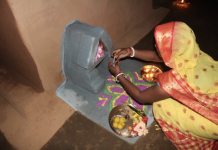The Meghalaya Governor Tathagata Roy recently tweeted, “A democracy is necessarily divisive. If you do not want it, go to North Korea”, even before the protestors against Citizenship Amendment Bill (Now an Act), 2019 in Shillong reached his official residence. His tweet is a small but significant statement that constitutes the supposedly majoritarian discourse on anxiety and fear that the BJP regime justifies to have been well consumed by the people of the country, and claims too powerful to be defeated.
The resistance to these “making up” of people in the majoritarian discourse are often externalised and exiled beyond space of its spatial and mythical assertion. As with the ‘Anti-National’ discourse, Roy’s expressed desire to exile the ‘non-divisive’ and ‘democratic’ people of Meghalaya to “North-Korea” reasserts that sentimentality. These are not simple statements that are being repeated on an everyday level by the patriarchs of Hindutva for whom the idea of a nation is ‘undemocratic’ and ‘divisive’, and those who do not fit into that definition of the ‘Nation’ are advised, threatened, and now with CAA juridically excluded from the invincible territoriality guarded by Hindutva. There is no doubt that CAA is the manifestation of that desire packaged in the form of a majoritarian anxiety, and by now well translated into the definite fear of the Muslims. CAA in a way is a vindication integral to these “myths of invincibility” on similar terms with abrogation of article 370, and recent verdict on Ram Mandir in Ayodhya.
Even before CAB was debated and voted in the Upper House, a series of discourses are being formulated and emerged from a geographical and cultural ‘frontier’ of the north-east. Frontier seems to be a living reality again, where anxiety, and fear culturally produced by the current BJP regime were sought to be normalised at the level of the everyday. However, was resisted as the recent protests on the streets of Assam and elsewhere in the north-east against CAB suggests. The protests are also suggestive of the way a particular narrative of territoriality has been challenged along with its attended anxieties. It can very well be interpreted that the “myth of invincibility” of this culturally produced majoritarian anxiety is showing signs of collapse at these cultural ‘frontiers’ of the Indian State. However, the centre through the act sought to divide the opposition to it by the cosmetic applications like the ‘Bengal Eastern Frontier Regulation’, 1873. The hypocrisy of this cosmetic application is not hard to visualise. One way the government is anxious to expand the cultural frontiers of their ideology and phobia to the northeast, and at the same time pretending to be respecting the cultural and political autonomy of spaces through these lines. The celebrations on the part of certain sections belonging to the north-east should be reminded that these jubilations through social media on this recent addition to the 2019 variant of CAB as Sanjib Frontline wrote in the Frontline “entirely redundant”. It can be seen as a mitigation of their’ own anxieties of being or dwelling in the north-east with their consent, already given to the ruling dispensation.
However, pertinent question here is whether these anxieties expressed are a counter to the “invincible myth” of the majoritarian discourse? To what extent these have the potential in collectively mobilising against the majoritarian discourse? By now it is certain that anxiety expressed by ‘ethno-nationalist’ discourse is decisive but its presumed exclusivity is little worrisome in the present context as the CAA in this discourse seems to be a disconnected with the NRC (specially its Post-CAA communal). The fear and anxiety the majoritarian state unleashed requires a collective counter narrative form the region. The popular discourse emerging as a reaction to the CAA circulated through social media platforms that project CAA to be Assam specific as it is ‘Assamese people versus the illegal immigrants’ compared to rest of India where it is ‘Hindus versus Muslims’ rests on this disconnectedness. If this disconnectedness persists, apprehensions are expressed that the regime would succeed in its aggressive territorial and cultural project. A collective mobilisation of people’s anxieties against the cultural project of Hindutva should not lost sight of at this critical juncture. The invincible might of the majoritarian state is brutally manifested in the series of atrocities done on the protestors in North-East as well as on students of Jamia Milia, Jawaharlal Nehru University, Aligarh Muslim University and others. Thinking spaces like universities are becoming new sites of state controlled violence in recent times.
If we look at the six years long Assam Movement (1979-85) that ended with a “practical” solution in the form of Assam Accord, these present ‘frontier’ anxieties, against the fear of dismantling the indigene demography of the region seems inevitable. However, it also becomes imperative to mention that, these anxieties and fear within the community hardly has been imagined in regard to different categories of people in Assam.
It deserves a mention here that, the emotions and anxieties at the present times resonates that of the beginning of Assam Movement in late 1970s and it would be naive to overlook the violent developments of a supposed secular agitation. A native outrage then in 70s and 80s indiscriminately against all the ‘immigrants’ got violently misdirected first towards the urban Bengali speaking middle class and then the soft target became Muslims whereby the migrant peasant Muslims were imagined as “obvious foreigners” and later these representations were materialised. The infamous Nellie massacre (1983) where Muslim peasants were massacred had subtly communalised the Assamese public sphere; both peasant Muslims and “indigenous” Muslims being at the receiving end. This led the rise of All Assam Minority Student’s Union (AAMSU) and Muslims looked up to alternative political articulation. Needless to say that one direct outcome of Assam Movement was self-articulation through their own political thought by several tribal groups like the Bodos, Tiwas ,Karbi etc.
The point, however, is whether or not we have learnt any lessons from history and what those lessons entail? At a time when analogies are drawn from 70s and 80s with the recent threats from the Citizenship Act, one need to be self-reflexive at every level while fighting back this communally motivated Act with outmost resistance. Resistance cannot be just put in a singular framework, but rather one should also be sensitive towards understanding the social categories of the state and their social and political history, as well as their anxieties. Muslim minorities of Assam, particularly anxieties of peasant migrant Muslims needs to be considered. Their anxiety starts from first being soft target of the agitation through stereotyping as “illegal immigrants” as it happened before and secondly, through agenda of majoritarian nationalism in general. The resistance, thus, must avoid all the previous historical blunders so that all section of minorities including Muslims and others including the Bengali and Hindi speakers can be accommodated. One needs to stop getting haunted by the imaginary spectrum of aggregated numbers of ‘illegal immigrants’ in Assam instigated by different political forces and defeat this cultural production of majoritarian discourse at the ‘frontier’ of its own creation.
Bikash Sarma teaches at Salesian College,Siliguri and Shofiul A. Pathan is an independent research scholar.











